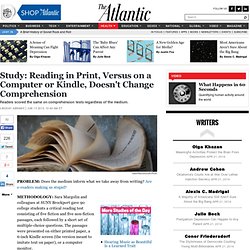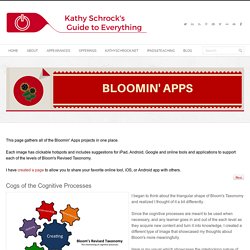

Study: Reading in Print, Versus on a Computer or Kindle, Doesn't Change Comprehension - Lindsay Abrams. Readers scored the same on comprehension tests regardless of the medium. runzwthscissors28/Flickr PROBLEM: Does the medium inform what we take away from writing?

Are e-readers making us stupid? METHODOLOGY: Sara Margolin and colleagues at SUNY Brockport gave 90 college students a critical reading test consisting of five fiction and five non-fiction passages, each followed by a short set of multiple-choice questions. The passages were presented on either printed paper, a 6-inch Kindle screen (the version meant to imitate text on paper), or a computer monitor. The students were allowed to spend as much time on the passages, which were all at a high school reading level and about 500 words in length, as they liked, but they weren't allowed to consult back once they began each question set.
RESULTS: Overall accuracy, at about 75 percent, was consistent regardless of whether the students read the passages on paper or a screen. Bloomin' Apps. This page gathers all of the Bloomin' Apps projects in one place.Each image has clickable hotspots and includes suggestions for iPad, Android, Google and online tools and applications to support each of the levels of Bloom's Revised Taxonomy.I have created a page to allow you to share your favorite online tool, iOS, or Android app with others.

Cogs of the Cognitive Processes I began to think about the triangular shape of Bloom's Taxonomy and realized I thought of it a bit differently.Since the cognitive processes are meant to be used when necessary, and any learner goes in and out of the each level as they acquire new content and turn it into knowledge, I created a different type of image that showcased my thoughts about Bloom's more meaningfully.Here is my visual which showcases the interlocking nature of the cognitive processes or, simply, the "Cogs of the Cognitive Processes".
IPAD APPS TO SUPPORT BLOOM'S REVISED TAXONOMYassembled by Kathy Schrock QR Code Generator: QR Stuff Free Online QR Code Creator And Encoder For T-Shirts, Business Cards & Stickers. 10 Video Projects Every Teacher Should Try. Making classroom movies has gotten much easier now that cell phones, tablets and other devices feature video capabilities that are high quality and simple to use.

And happily, we’ve found that students love to use video—it’s a format that they understand and that sparks their creativity. Here are ten ideas to try in your classroom today. Make a Book Trailer: Challenge students to design a movie-style trailer that excites their classmates about a must-read novel or nonfiction book. Try Digital Storytelling: Digital storytelling is a great format for students to share more about their lives or to present about a person in history. Film a Thank You Note: If you need to thank a visitor to your class or an awesome parent volunteer, try filming rather than writing a thank you note. 10 Podcasting Projects Every Teacher Should Try. If orange is the new black, podcasting is the new oral report.

And now that teachers have easy access to tools like Garage Band and iPods that make recording a breeze, podcasting is quickly becoming the latest creative mode of learning and presenting in schools. Here are ten ideas to try in your classroom today. Current Event Newscasts: Practice non-fiction reading skills by having your students do weekly or monthly podcasts on an interesting current event.
Favorite teacher sites. Favorite teacher tools. Online homework choices. Favorite student search engines. Digital storytelling.